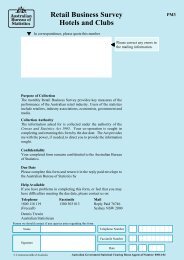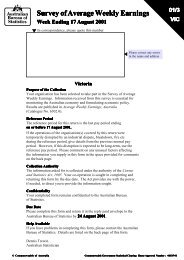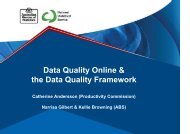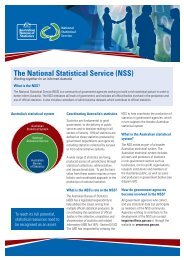SAE Manual Sections 1 to 4_1 (May 06).pdf - National Statistical ...
SAE Manual Sections 1 to 4_1 (May 06).pdf - National Statistical ...
SAE Manual Sections 1 to 4_1 (May 06).pdf - National Statistical ...
You also want an ePaper? Increase the reach of your titles
YUMPU automatically turns print PDFs into web optimized ePapers that Google loves.
A Guide <strong>to</strong> Small Area Estimation - Version 1.1 05/05/20<strong>06</strong><br />
!<br />
Calibration Estima<strong>to</strong>r<br />
To produce calibration estima<strong>to</strong>rs, the original survey weights (usually the<br />
inverse probabilities of inclusion in the sample) are replaced with new<br />
"calibrated" weights that are in some sense as close as possible <strong>to</strong> the original<br />
weights, but are calibrated on some auxiliary variable available for the<br />
population (Chambers, 2005). The small area estimate for this auxiliary<br />
variable, calculated using the calibrated weights, will agree with the known<br />
population <strong>to</strong>tals. A simple example of calibration is where population age by<br />
gender demographic <strong>to</strong>tals are known for each small area. The survey weights<br />
are then adjusted so that estimates of population count by age and gender,<br />
agree with the known population counts.<br />
There are a couple of points <strong>to</strong> note about the calibration estima<strong>to</strong>r. Firstly it is<br />
a straightforward method <strong>to</strong> put in<strong>to</strong> production because the resulting<br />
adjusted (calibrated) weights can be s<strong>to</strong>red on the survey file and used <strong>to</strong><br />
produce estimates at the desired level of aggregation. Secondly the auxiliary<br />
variables should be chosen with care and should relate <strong>to</strong> variables we wish <strong>to</strong><br />
produce estimates for. If the calibrated weights are used <strong>to</strong> produce estimates<br />
for variables that aren’t related <strong>to</strong> the auxiliary variable(s) used in determining<br />
the calibrated weights, the resulting estimates may be biased. In general<br />
calibrated estimates possess good design-based properties. Government<br />
statisticians have his<strong>to</strong>rically preferred the design-based <strong>to</strong> the model-based<br />
approach as the resulting estimates are not subject <strong>to</strong> the consequences of<br />
model mis-specification.<br />
4.1.2 Regression Methods<br />
Where a higher level of accuracy is required for small area estimates, an alternative is <strong>to</strong><br />
use regression or model-based approaches, however these methods require a higher<br />
level of statistical expertise <strong>to</strong> implement and interpret results. A wide variety of<br />
different regression techniques are available, but for the purposes of this manual, they<br />
are divided in<strong>to</strong> two main categories: synthetic and random effects regression models.<br />
!<br />
Synthetic Regression Models<br />
Synthetic regression models make use of available auxiliary data <strong>to</strong><br />
mathematically express a deterministic relationship between those auxiliary<br />
variables and the target (response) variable we are trying <strong>to</strong> predict in each<br />
small area. Synthetic models assume that all the systematic variability in the<br />
response variable is explained by the variability in the values of the auxiliary<br />
variables. The remaining variability, which is referred <strong>to</strong> as the "random noise"<br />
or "s<strong>to</strong>chastic variation", is represented by the difference between the<br />
predicted value for the response variable under the model and the value<br />
observed from the data. These differences are called random errors, residuals<br />
or disturbances.<br />
In the case of small area models, synthetic models assume that the same<br />
deterministic relationship between the variable of interest and the auxiliary<br />
variables, holds across a range of small areas, say for example within a state.<br />
Australian Bureau of Statistics 26








